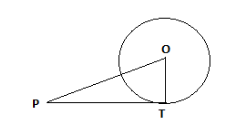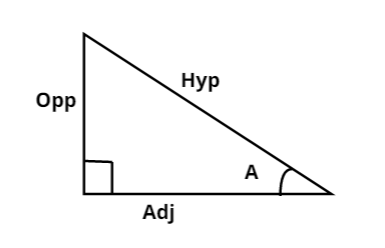
In the following figure $PT$ is of length $8cm$, $OP$ is $10cm$, Then the radius of the circle is

${
A.2cm \\
B.18cm \\
C.1cm \\
D.6cm \\
} $

Answer
574.8k+ views
Hint: First of all, read the question very carefully that will help you to have a mind map how it should be solved. We can easily find out the radius of the circle by using Pythagoras theorem. It is the key formula to solve this type of question easily and confidently without any error. A triangle (right angle triangle) has three sides hypotenuse denoted by $(h)$, base $(b)$, and perpendicular $(p)$.
Complete step-by-step answer:
$OP$ is the hypotenuse $\left( n \right)$ of the triangle $OPT$ and $TP$ is the base of the triangle $OPT$.\[OT\] is the perpendicular of the triangle.
If we see the figure, we can conclude that \[OT\]. That is the perpendicular of \[\Delta PTO\] is the radius of the circle.
Here we have to apply Pythagoras theorem in the right angled triangle OPT.
Pythagoras theorem states that in a right-angled triangle, the square of hypotenuse is equal to the sum of squares of base & perpendicular.
So, applying Pythagoras theorem here,
\[\therefore {h^2} = {p^2} + {b^2}\]
\[\therefore O{P^2} = {\left( {TO} \right)^2} + {\left( {PT} \right)^2}\]
[ Given, \[\therefore O{P^2} = {\left( {TO} \right)^2} + {\left( {PT} \right)^2}\]]\[................(i)\]
By putting the value \[(i)\] we get:
\[\therefore {\left( {OP} \right)^2} = {\left( {TO} \right)^2} + {\left( {PT} \right)^2}\]
\[{
{\left( {10} \right)^2} = {\left( 8 \right)^2} + {\left( {OT} \right)^2} \\
O{T^2} = 100 - 64 \\
\sqrt {{{\left( {OT} \right)}^2}} = \sqrt {36} \\
OT = 6cm \\
} \](by square root on both side)
Therefore, the radius of the circle will be $6cm$. As we know that $OT$ is the radius.
Note: It is above figure by observing very carefully. We can conclude that the perpendicular of the triangle $OPT$ is the radius of the circle.

In a right angled triangle,
The side opposite to the angle A is called opposite. The side opposite to the right angle is hypotenuse and
The other side is called the adjacent.
Complete step-by-step answer:
$OP$ is the hypotenuse $\left( n \right)$ of the triangle $OPT$ and $TP$ is the base of the triangle $OPT$.\[OT\] is the perpendicular of the triangle.
If we see the figure, we can conclude that \[OT\]. That is the perpendicular of \[\Delta PTO\] is the radius of the circle.
Here we have to apply Pythagoras theorem in the right angled triangle OPT.
Pythagoras theorem states that in a right-angled triangle, the square of hypotenuse is equal to the sum of squares of base & perpendicular.
So, applying Pythagoras theorem here,
\[\therefore {h^2} = {p^2} + {b^2}\]
\[\therefore O{P^2} = {\left( {TO} \right)^2} + {\left( {PT} \right)^2}\]
[ Given, \[\therefore O{P^2} = {\left( {TO} \right)^2} + {\left( {PT} \right)^2}\]]\[................(i)\]
By putting the value \[(i)\] we get:
\[\therefore {\left( {OP} \right)^2} = {\left( {TO} \right)^2} + {\left( {PT} \right)^2}\]
\[{
{\left( {10} \right)^2} = {\left( 8 \right)^2} + {\left( {OT} \right)^2} \\
O{T^2} = 100 - 64 \\
\sqrt {{{\left( {OT} \right)}^2}} = \sqrt {36} \\
OT = 6cm \\
} \](by square root on both side)
Therefore, the radius of the circle will be $6cm$. As we know that $OT$ is the radius.
Note: It is above figure by observing very carefully. We can conclude that the perpendicular of the triangle $OPT$ is the radius of the circle.

In a right angled triangle,
The side opposite to the angle A is called opposite. The side opposite to the right angle is hypotenuse and
The other side is called the adjacent.
Recently Updated Pages
Master Class 9 Social Science: Engaging Questions & Answers for Success

Master Class 9 Science: Engaging Questions & Answers for Success

Master Class 9 English: Engaging Questions & Answers for Success

Master Class 9 Maths: Engaging Questions & Answers for Success

Master Class 9 General Knowledge: Engaging Questions & Answers for Success

Class 9 Question and Answer - Your Ultimate Solutions Guide

Trending doubts
Which places in India experience sunrise first and class 9 social science CBSE

Fill the blanks with the suitable prepositions 1 The class 9 english CBSE

Write the 6 fundamental rights of India and explain in detail

Difference Between Plant Cell and Animal Cell

What is pollution? How many types of pollution? Define it

What is the Full Form of ISI and RAW




